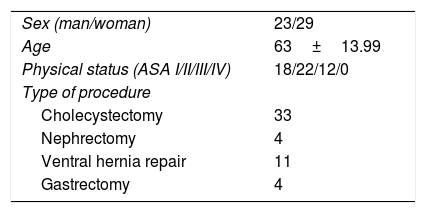The administration of local anaesthetic in the serratus-intercostal space provides adequate analgesia in non-reconstructive breast surgery. The aim of this study was to evaluate whether the blockage of the last intercostal nerves (T7–T11) can lead to opioid savings in supra-umbilical open surgery procedures.
Material and methodsA prospective observational study was conducted on patients undergoing open supra-umbilical surgery under general anaesthesia and with a serratus-intercostal plane block [modified Blocking the bRanches of IntercostaL nerves in the Middle Axillary line (BRILMA)] as an associated analgesic strategy. Post-operative pain was assessed with the numerical verbal scale (NVS 0–10) on admission to the post-anaesthesia recovery unit, at 6, 12, 24, and 48h post-intervention and by need for analgesic rescues with opioids (2mg iv of morphine, if values higher than 3 in NVS). Adverse events related to the technique were also recorded. The statistical package used in the analysis of the data was SPSS® for Windows.
ResultsThe study recruited 52 patients. Differences, with a p<0.05, were found intra-operatively in the consumption of fentanyl: 400±80μg versus 110±50μg in patients who underwent pre-incisional blockade. In the first 24h, only three cases (two gastrectomies and one cholecystectomy) required morphine (single bolus of 2mg). Between 24 and 48h, it was necessary to administer several morphine boluses (8+2mg) in four patients (three gastrectomies and one cholecystectomy). Four patients presented with nausea and/or vomiting and there were no complications related to the analgesic technique.
ConclusionThe intercostal nerves block (T7–T11) in the serratus-intercostal space may constitute an opioid-sparing analgesic strategy in open supra-umbilical surgery.
La administración de anestésico local en el espacio serrato-intercostal (BRILMA) proporciona analgesia adecuada en cirugía no reconstructiva de mama. Nuestro objetivo ha sido evaluar si el bloqueo de los últimos nervios intercostales (T7-T11) puede permitir un ahorro de opioides en procedimientos de cirugía abierta supraumbilical.
Material y métodosEstudio observacional prospectivo de pacientes sometidos a cirugía supraumbilical abierta bajo anestesia general y bloqueo del plano serrato-intercostal (BRILMA modificado) como estrategia analgésica asociada. El dolor postoperatorio se valoró mediante la escala verbal numérica (EVN 0 a 10) al ingreso en la unidad de recuperación postanestésica, a las 6, 12, 24 y 48h postintervención y mediante la necesidad de rescates analgésicos con opioides (2mg iv de morfina si los valores eran superiores a 3 en EVN). También se registraron los eventos adversos relacionados con la técnica. El paquete estadístico aplicado fue SPSS® para Windows en el análisis de los datos.
ResultadosEl estudio reclutó 52 pacientes. Intraoperatoriamente, con p <0,05, se han encontrado diferencias en el consumo de fentanilo: 400 ± 80μg versus 110 ± 50μg en pacientes a los que se realizó el bloqueo preincisional. En las primeras 24h solo tres casos (dos gastrectomías y una colecistectomía) precisaron morfina (bolo único de 2mg). Entre las 24h y 48h fue necesario administrar varios bolos de morfina (8 ± 2mg) en cuatro pacientes (tres gastrectomías y una colecistectomía). Presentaron náuseas y/o vómitos cuatro pacientes y no hubo complicaciones relacionadas con la técnica analgésica.
ConclusiónEl bloqueo de los nervios intercostales (T7-T11) en el espacio serrato-intercostal puede constituir una estrategia analgésica ahorradora de opioides en cirugía abierta supraumbilical.
Artículo
Comprando el artículo el PDF del mismo podrá ser descargado
Precio 19,34 €
Comprar ahora








